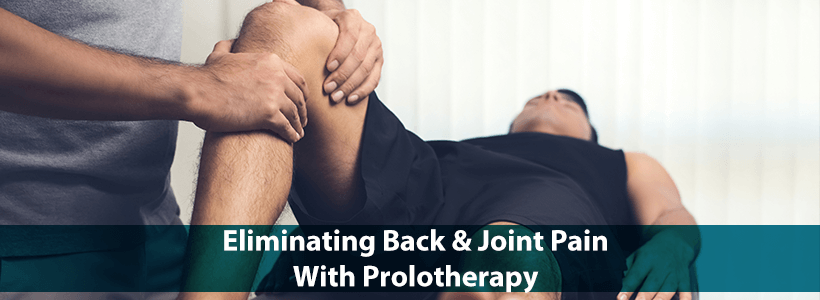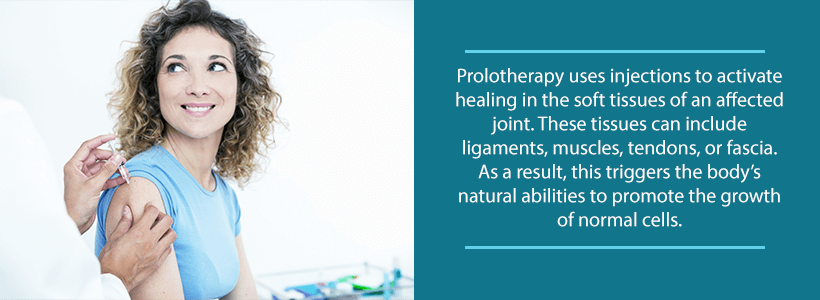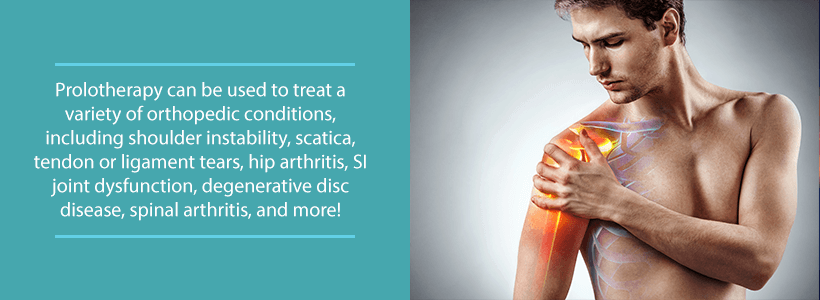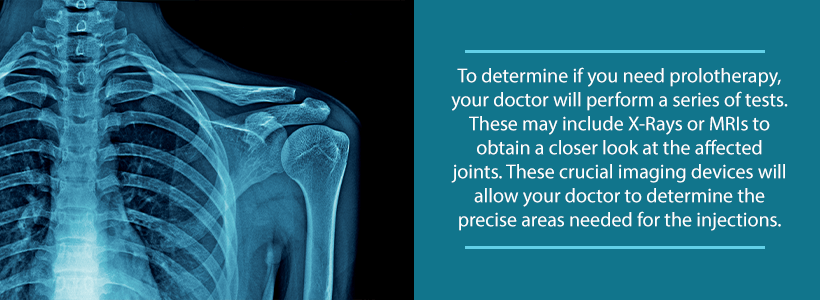If you’re dealing with frequent back or neck pain, your posture might be playing a bigger role than you think. Whether you're sitting at a desk all day or scrolling on your phone for hours,…
Back and joint pain can prevent you from enjoying life. In fact, just about every movement you make can become painful if you suffer from either one of these conditions. Chronic back pain affects your ability to work, participate in hobbies, and share important moments with family and friends. If you’ve tried conservative treatments without success…. Then, you’re probably desperate for the right answer. And, while surgery may be an option for you, you may also be leery of “going under the knife.”
Alternative therapies are available for those who wish to avoid surgery. Instead, prolotherapy uses the body’s natural healing response to treat a variety of painful orthopedic conditions. While prolotherapy has its roots in ancient Egyptian times, it’s modern-day origins can be traced to the early 20th century. Can this treatment help you? Use this guide to understand prolotherapy and how it can relieve your pain.
What is Prolotherapy?
Prolotherapy uses injections to activate healing in the soft tissues of an affected joint. These tissues can include ligaments, muscles, tendons, or fascia. As a result, this triggers the body’s natural abilities to promote the growth of normal cells and tissues. Sometimes known as sclerotherapy or regenerative injection therapy, this treatment has shown promising results in treating back and joint pain. Studies are limited, however, and more widespread research is needed to determine overall success rates.
During prolotherapy, a trained physician or orthopedic doctor uses a series of injections over the course of 3 to 6 months. Generally, treatments take place every couple of weeks. Most injections contain a natural irritant—usually dextrose or glucose. In some cases, sodium morrhuate (a derivative of cod liver oil) may be used.
These injections activate special proteins in the body known as growth factors. Over time, these factors strengthen the affected soft tissues, helping to stabilize the joint.
What Conditions Does Prolotherapy Help?
Prolotherapy can be used to treat a variety of back and joint issues. While some evidence is anecdotal, a growing number of individuals who deal with joint pain swear by this treatment. Here are some conditions that doctors use prolotherapy to treat:
- Degenerative Disc Disease:As we age, the discs protecting our spine tend to dry out and lose shape. This creates an instability in the spine that often leads to back pain and nerve damage.
- Hip Arthritis or SI Joint Dysfunction: Issues with inflammation of the hip joints and improper movement of the lower spine can result in pain in the legs and lower back.
- Spinal Arthritis: Arthritis involves the breakdown of cartilage in the joints and discs of the spine. This usually occurs in the neck or lower back.
- Sciatica: Pain radiating from the lower back to one or both legs, caused by pressure on the sciatic nerve.
- Ligament and Tendon Tears: Trauma, falls, and other injuries can cause pain and inflammation in the body’s connective tissues.
- Shoulder Instability: If you‘ve suffered a shoulder dislocation because of repeated use or sudden injury, then it is more likely to pop out again without treatment.
Who is a Good Candidate for Prolotherapy?
While prolotherapy is helpful for some individuals, others may not benefit from this type of treatment. Talking to your doctor or spine surgeon can help you make an educated decision about pursuing prolotherapy.
Typically, those who would benefit from prolotherapy:
- Have had back or joint pain, especially resulting from an injury to ligaments or tendons, for over six weeks.
- Use medications for back and joint pain management.
- Experience more joint pain during physical activities and less while resting.
- Haven’t achieved long-term relief from physical therapy or other manual therapies.
Types of Prolotherapy
There are three types of prolotherapy in common use today. These include:
- Growth Factor Injection Prolotherapy: Injecting a complex protein into a joint to activate the growth of certain cells. This may help to alleviate pain from arthritis and muscle sprains or strains.
- Growth Factor Stimulation Prolotherapy: Instead of using complex proteins, this type of injection uses a non-inflammatory injection of dextrose—less than 10% of the injection solution. This encourages the body to produce growth factors on its own.
- Inflammatory Prolotherapy: A higher concentration of dextrose (up to 25%) may be used to stimulate temporary inflammation to the affected area. This triggers a more vigorous growth response in the body.
What to Expect During a Prolotherapy Treatment
Before receiving any type of injection, your doctor will make sure your back and joint pain is properly diagnosed. This involves obtaining a full medical history, discussing the onset and severity of symptoms, and receiving a physical examination. In addition, your doctor may order X-rays and other diagnostic imaging to obtain a clearer picture of the affected area. Since prolotherapy may not benefit everyone, it is crucial to know the exact cause of your pain.
After the examination, your doctor will discuss treatment options, benefits, and side effects of prolotherapy. If it is advised, then you should stop taking any anti-inflammatory medications a couple of days before the procedure. Unlike some procedures, your doctor may also ask you to eat a protein-rich meal prior to the injection.
During a prolotherapy treatment, a doctor uses local anesthesia, such as lidocaine or procaine, to numb the area. Then the doctor uses a long, thin needle to deliver the injections around the damaged area. The number of injections will depend on your specific condition.
After the injections, you may experience side effects for up to three days after the procedure. This includes stiffness, pain, and swelling. Pain medications can help during this interval. Be sure not to use aspirin or an anti-inflammatory medication. These types of drugs may make the injections less effective. In addition, icing the area and mild exercise can be beneficial to achieving relief. Physical therapy is also often required to restore function to the affected area.
Other Therapies That May Be Helpful for Treating Pain
- Platelet Rich Plasma Therapy (PRP): News reports of famous athletes using PRP gave this therapy national attention. Your platelets, cell fragments in the blood, contain hundreds of growth factors that help to heal injuries. By injecting a high concentration of platelets into an affected area, it stimulates the body’s natural healing process.
- Stem Cell Therapy: Stem cells have the ability to build and rebuild every tissue in the body. Think of these as “wild card” cells. They can divide continuously to make whatever the body needs for healthy regeneration of an injured area. Implanting these cells back into the body can potentially address a variety of injuries, diseases, and disorders.
Are You Ready to Get Help with Your Back and Joint Pain?
If you tried other conservative treatments and still haven’t found success, Orthopedic & Laser Spine Surgery is ready to help you. We take the time to listen to your story, symptoms, and goals for treatment. After pinpointing the source of your pain, we discuss the most appropriate options for your condition.
At Orthopedic & Laser Spine Surgery, our back doctors use the latest technology and research to help you achieve a pain-free life. This includes alternative treatments like prolotherapy, stem cell therapy, and platelet-rich plasma therapy. In addition, we specialize in minimally invasive procedures for a variety of spine and orthopedic issues.
With access to so many treatments, you may finally be able to find the answer to a pain-free life. Don’t suffer any longer. Calling (855) 853-6542 will put you in touch with a dedicated team who is devoted to your recovery.




